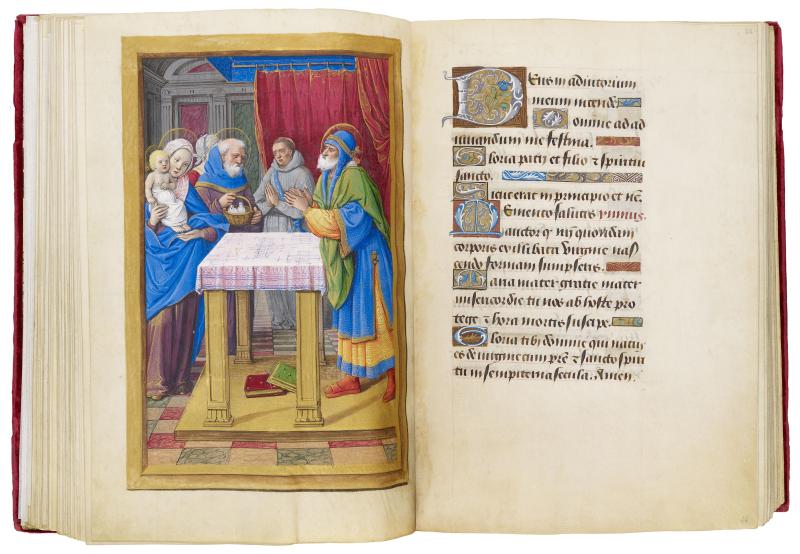
None: Presentation in the Temple
Hours of Henry VIII
Illuminated by Jean Poyer
Gift of the Heineman Foundation, 1977
None: Presentation in the Temple (fol. 65v)
The traditional illustration for None is the Presentation of Christ in the Temple. According to Luke (2:22–40), the Holy Family would be met by Simeon, who was inspired by the Holy Spirit to recognize, before his own death, the Savior.
The altar itself, complete with a blue canopy and red curtains, is situated within a Renaissance interior with walls decorated with pilasters framing large red and green marble panels, echoing the rows of colored floor marbles. The five large crosses that decorate the altar cloth, suggesting the five wounds Christ would endure on the Cross, may allude to Simeon's vision.
As was common in later medieval art, Poyer has identified Simeon with the high priest of the Temple; he would proclaim that the Lord could now let him depart in peace, having seen his salvation. The famous Canticle of Simeon, beginning Nunc dimittis (Now you may dismiss me), does occur in the Hours of the Virgin but at Compline. Poyer has given him a halo because he was subsequently made a saint; the letters on the hem of his garment suggest Hebrew. After blessing the Holy Family, Simeon told Mary that her child was set for the fall and resurrection of many in Israel and a sword would pierce her own soul.
The unusual presence of a Franciscan friar behind the altar suggests that the original owner may have had some connection or special devotion to that order, which was especially favored by French royalty at this time. The manuscript's Calendar has a strong emphasis on Franciscans. They were known as Gray Friars because of the color of their habit, which was originally gray (but later brown).
Luke 2:22–40
The only biblical account for the Presentation of Christ in the Temple is Luke's (2:22–40): "After the days of her purification . . . they carried him to Jerusalem, to present him to the Lord . . . as it is written that every male opening the womb shall be called holy to the Lord, and to offer a sacrifice . . . a pair of turtledoves or two young pigeons." (The sacrificial birds, following Leviticus 12:6–8, were for the purification of women after childbirth.)
